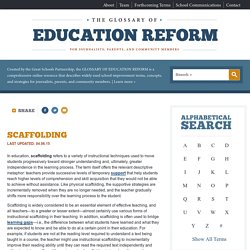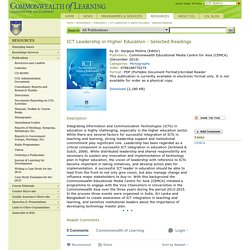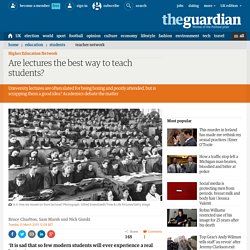

Five academic papers all teachers need to read. This blog post is a quick summary of five of the academic papers that have most influenced me in my development as a teacher, and I would heartily recommend all five to other teachers.

I do not always agree with every single thing written in these papers (although I generally do agree with the overall thrust of their argument), but I have found these papers useful springboards to further thought, and, for those of you who read my blog regularly, you will no doubt see how my posts resonate with the ideas in these five papers.
All of these papers are behind pay-walls, but most (if not all) can be found for free online with a little searching. (1) P. Hirst, ‘What is teaching?’ , Journal of Curriculum Studies, 3.1, (1971) I like this paper for its clarity, setting out on a conceptual analysis of the term ‘teaching’. Scaffolding Definition. In education, scaffolding refers to a variety of instructional techniques used to move students progressively toward stronger understanding and, ultimately, greater independence in the learning process.

The term itself offers the relevant descriptive metaphor: teachers provide successive levels of temporary support that help students reach higher levels of comprehension and skill acquisition that they would not be able to achieve without assistance. Like physical scaffolding, the supportive strategies are incrementally removed when they are no longer needed, and the teacher gradually shifts more responsibility over the learning process to the student. Scaffolding is widely considered to be an essential element of effective teaching, and all teachers—to a greater or lesser extent—almost certainly use various forms of instructional scaffolding in their teaching. Scaffolding vs. The following examples will serve to illustrate a few common scaffolding strategies: Teaching in a Digital Age: Guidelines for Teaching and Learning. Tony Bates, a Contact North I Contact Nord Research Associate, has released his latest book on technology and learning as an online, open textbook.

Blended Learning: Resource Roundup. The 10 Biggest Breakthroughs in the Science of Learning. Greater understanding of our brain’s functioning, abilities, and limitations allows us to constantly improve our teaching skills and the productivity of our Brainscape study sessions and working hours (and after-work hours, for that matter).

We’ve already given you tips on how to keep your brain in shape and how to boost your brain’s abilities through exercise. This article, originally published by OnlinePHDPrograms.com, shares the 10 most significant breakthroughs that recent research has made on the science of learning, providing valuable insights on how to make the best use of your brain without wasting energy. When it comes to human organs, none is quite so mysterious as the brain. For centuries, humans have had numerous misconceptions and misunderstandings about how the organ works, grows, and shapes our ability to learn. 1.
This term has become a major talking point in criticisms of multi-tasking, especially given the modern information-saturated world we live in. 2. 3. Dr. Patrick Blessinger. ICT Leadership in Higher Education - Selected Readings. Description Integrating Information and Communication Technologies (ICTs) in education is highly challenging, especially in the higher education sector.

While there are several factors for successful integration of ICTs in teaching and learning, strong leadership support and institutional commitment play significant role. Leadership has been regarded as a critical component in successful ICT integration in education (Kirkland & Sutch, 2009). While distributed leadership and shared responsibility are necessary to sustain any innovation and implementation of technology plan in higher education, the vision of leadership with reference to ICTs become important in taking initiatives, and develop action plan for implementation. A successful ICT leader in education should be able to lead from the front to not only give vision, but also manage change and influence major stakeholders to buy-in. Reader Comments. Donald Clark Plan B. Had a wonderful experience this week – over two days I watched all 12 episodes of ‘The Wire’ (possibly the best TV series I’ve ever watched) on video on demand.

I’ve ordered the next two series on DVD. It got me thinking. TV programmes start on the hour or half hour. Why? So we remember when to watch them – they’re timetabled. In learning, time is tragically tyrannical. 1. 2. 3. 4. Ken Robinson: Changing education paradigms. Are lectures the best way to teach students? ‘It is sad that so few modern students will ever experience a real lecture’ Bruce Charlton, reader in evolutionary psychiatry, Newcastle University, says: Real lectures are always greatly appreciated by students who want to learn.

But what are called “lectures” nowadays are a travesty. Vast, stuffy venues that seat hundreds; students sitting in the dark and unable to see the speaker; a disembodied voice droning into a microphone; the lecturer reading out endless powerpoint slides which have already been posted online; the scanty audience passive instead of actively making their own notes – distracted by themselves and others intermittently browsing the internet and social networks; and the whole thing being recorded as if to emphasise to students that they don’t really need to be there nor pay attention. Formative assessment.